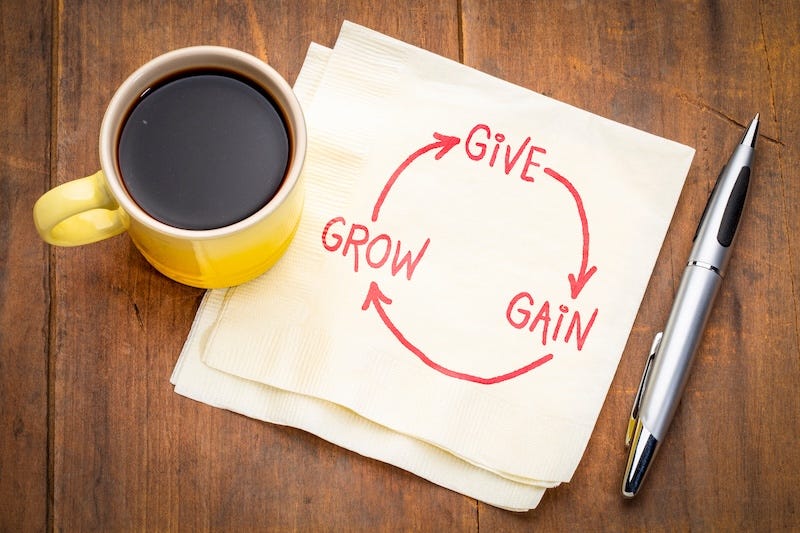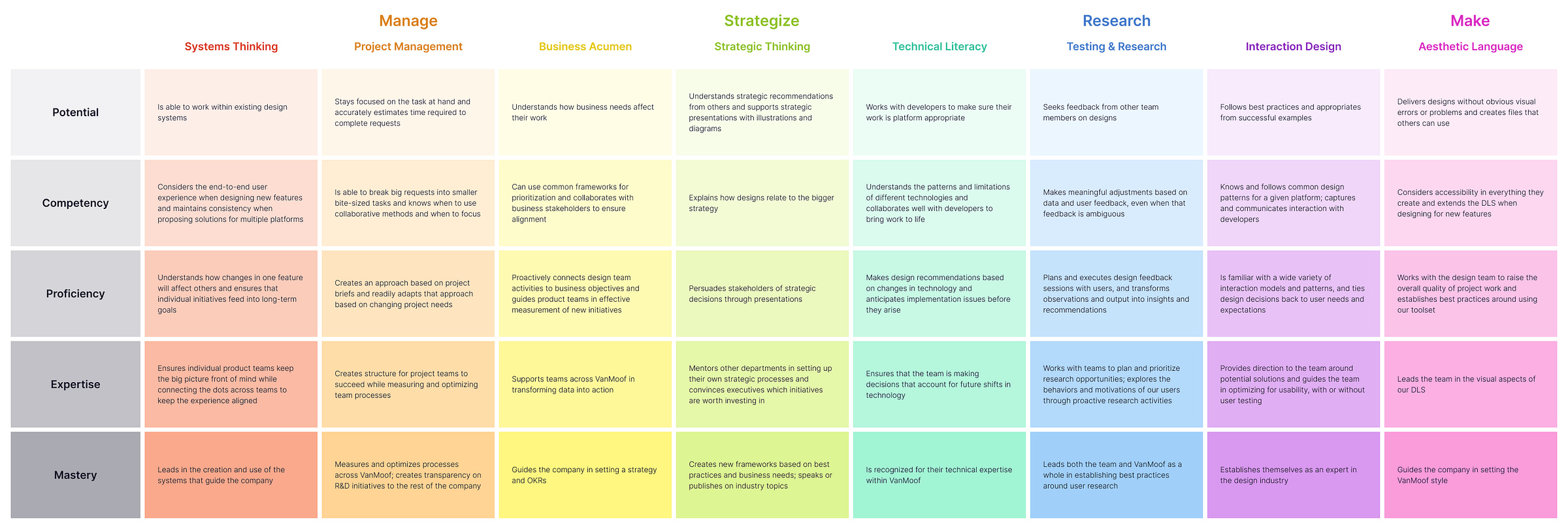Building Exceptional, and Slightly Less Chaotic, Product Design Teams
Lay the foundation for collaborative, growth-oriented, and results-driven design organizations... or, you know, try to keep things from completely falling apart.
Summary: This article is for design leaders (new and seasoned) and senior designers who aspire to build, nurture, and elevate their teams. We'll explore strategies to move beyond a collection of individual talents and cultivate a high-impact design team. Forget the idea of the lone genius; real impact in design is a team sport, where everyone's got each other's backs and pushes towards the same goal.
The Symphony of Skills
I'll never forget my first design leadership role. I was convinced that the key to success was assembling a team of rockstar designers, you know, the kind who are basically fire hoses of innovative ideas and possess jaw-dropping visual design skills. I spent months recruiting top talent, and I was ecstatic when I finally had a team full of them.
But then reality set in. Instead of a beautiful symphony, I found myself leading a group of brilliant soloists, each playing their own music, often clashing with one another. It was a frustrating and an extremely humbling experience. I learned the hard way that building a high-performing product design team is about so much more than getting the "best" of the "best" on the team. Turns out, "best" is subjective, and sometimes, "best" designers are the ones who play well with others. Who knew?
Building a high-performing product design team is about creating collaboration, and it goes beyond just assembling talent (although that is a big factor). It involves strategic leadership, a strong foundation of trust and clear purpose, a commitment to continuous growth, and the ability to effectively measure and communicate the team's impact. It's similar to conducting an orchestra where everyone's in sync and playing their heart out for the same song. The design leader in this scenario? They're the conductor, ensuring all that individual brilliance comes together to create powerful design. Or, more accurately, they're trying to prevent the brass section from starting a turf war with the percussionists.
A Foundation of Clarity, Confidence, and Minimal Confusion
Have you ever tried to get a group of friends to decide on a dinner spot? If everyone's throwing out random ideas and there's no clear direction, you usually end up with a lot of frustration and empty stomachs. It gets a lot easier if you all have a similar genre of food in mind. The same kind of goes for a product design team. You absolutely need a clear vision and purpose,that agreed-upon genre of food, so everyone understands what the goal is and why their work actually matters. The leader needs to be the one clearly saying, "Alright team, this is our destination, and here's why it's going to be great when we get there." (And maybe offering to buy the first round of drinks).
A clear vision and purpose provide the essential "why" behind the work. It's the North Star that guides the team's efforts and aligns individual contributions with overarching goals. For design leaders, this means:
Connect to the "Why": Don't just state what the team does; articulate why it matters. How does the team's work impact users? How does it impact the business? What problem are they solving? Connect the daily tasks to a larger, inspiring mission. (Even if that mission is "to make this app slightly less annoying to use.") To make this super clear, try framing it like this: "Our work directly impacts X metric, which leads to Y business outcome. That's why your contribution is so valuable."
Involve the Team: Make the vision and purpose a collaborative effort. Solicit input from team members to create a sense of ownership, accountability, and shared understanding. When people feel heard, they're more invested. (And less likely to passive-aggressively change the font size on everything.) A great way to do this is by holding a team workshop where you brainstorm the vision together.
Communicate Consistently: Regularly reiterate the vision and purpose in team meetings, project kick-offs, and even informal conversations. Keep it top-of-mind. I graffitied our vision and purpose on an office wall at a prior workplace. I don't recommend this, the building operations people hated me.
Make it Tangible: Translate the abstract vision into concrete goals and objectives that the team can work towards. Show how their individual contributions directly feed into the larger purpose. A helpful technique here is to use the OKR (Objectives and Key Results) framework, which can provide a clear roadmap for everyone.
Now, imagine that dinner again. If you suggest a place and everyone just shoots it down immediately, or if you spill your drink and everyone just stares at you, you're probably not going to feel very comfortable sharing ideas or taking risks in the future. That's why psychological safety is HUGE. It's creating a space where everyone feels like they can throw out ideas (even the crazy ones!), ask "dumb" questions (there are no dumb questions, just varying levels of knowledge!), and even mess up a little without feeling like they're gonna get roasted. When people feel safe, that's when real creativity happens.
For design leaders, creating psychological safety involves:
Lead by Example: Be open about your own mistakes and learning experiences. Show vulnerability to encourage others to do the same. It's saying, "Hey, I messed up on this, and here's what I learned," which makes it okay for others to do the same.
Actively Listen and Validate: When team members share ideas or concerns, listen attentively and acknowledge their perspective, even if you don't agree. (Nodding and saying "Interesting..." is a good start, even if you're thinking, "Are you serious?") Try using phrases like, "I hear what you're saying, and that's a valid point," to show you're listening.
Normalize Failure as Learning: Frame mistakes as opportunities for growth, not as reasons for blame. Focus on what can be learned and how to improve. (Think “retrospective" instead of "public shaming.") A key mindset shift is to move from "Who's to blame?" to "What can we learn for next time?"
Establish Clear Norms: Create team agreements about respectful communication, constructive feedback, and how disagreements will be handled. (Like, "No interrupting, unless someone is about to suggest using Clippy.") These norms could include things like, "Assume positive intent" and "Critique the design, not the designer."
Celebrate Risk-Taking (Even if it Doesn't Work Out): Acknowledge and appreciate when team members step outside their comfort zones and try new things, regardless of the outcome. (Bonus points if the "failure" is spectacularly funny.) This could involve a team shout-out or even a small reward for "most daring idea."
And finally, back at dinner again, think about ordering. If your waiter takes your order and you don't hear anything until the food magically appears (or doesn't!), you're going to be pretty in the dark. Effective feedback loops are like those check-ins with your waiter , "Hey, just wanted to let you know the kitchen's working on your burger!" Regular feedback, both giving and getting, keeps everyone on the same page, helps catch issues early, and makes the final product way better. (And prevents designers from spending weeks on a feature that gets scrapped.)
Design leaders can establish effective feedback loops by:
Implement Regular Cadences: Schedule recurring feedback sessions at different levels (individual, project, team). This could be weekly check-ins, mid-project reviews, or post-project retrospectives. Of course, let your designers actually design at some point. A good rule of thumb is to have at least one formal feedback session per project milestone, in addition to regular informal check-ins.
Encourage Both Giving and Receiving: Create a culture where everyone feels comfortable giving and receiving feedback. Provide training on how to deliver constructive feedback effectively. (Tip: Start with something positive, even if it's just, "I like the shape of that...")
Make it Specific and Actionable: Feedback should be focused on behaviors and outcomes, and it should provide clear steps for improvement. Avoid vague or personal criticisms. ("This design is bad" is less helpful than "I'm not sure the color contrast meets accessibility standards.") Instead of saying "I don't like it," try saying "I'm having trouble understanding X. Could we explore Y?"
Create Multiple Channels: Offer various ways to give feedback, both formal and informal, written and verbal. This can include one-on-one meetings, team critiques, and anonymous surveys. Think about using a tool like Loom for asynchronous video feedback, which can be really helpful for visual design.
Close the Loop: Feedback should be actionable. So make sure that feedback is actually acted upon and that team members see the impact of their input. This shows that their feedback is valued. (And that they're not just shouting into the void.) This means following up and saying, "Based on your feedback, we changed X, and here's the result."
Investing in Talent and Teamwork
Okay, so you've got a team with a clear direction and a safe creative space. What's next? Making sure everyone keeps getting better! The key here is intentional skill development. It's the design leader's responsibility to actively support the growth of team members. This could be anything from pairing up a junior designer with a senior, sending teams to workshops that'll blow their minds, or just carving out time for the team to share what they're learning. When people are constantly learning and growing, the whole team gets stronger. (And less likely to leave for a company that offers free learning and development opportunities.)
Design leaders should invest in the growth of their team members by:
Identify Skill Gaps: Regularly assess the team's current skills and future needs. What new technologies or methodologies are becoming important? Where are there opportunities for growth? (Besides "patience" for dealing with stakeholders?) A skills matrix can be a useful tool, helping you visualize where everyone stands and where the gaps are.
Create Learning Pathways: Develop structured plans for skill development, which might include mentorship, online courses, internal workshops, or conference attendance. Try creating a "learning budget" for each team member and encouraging them to use it for their professional development.
Establish a Culture of Sharing: Encourage team members to share their knowledge and expertise through presentations, informal discussions, or internal documentation. Consider setting up a regular "Design Share" session where team members can present their work and learnings to each other.
Provide Opportunities for Experimentation: Create a space for designers to try new techniques and tools, even if the outcome isn't always perfect. Learning often happens through doing. (And sometimes, spectacular failures lead to unexpected breakthroughs.) This could involve dedicated "innovation sprints" or "hackathons" where designers can explore new ideas.
Recognize and Reward Growth: Acknowledge and celebrate when team members develop new skills or take on new challenges.
But just like in nature, nothing grows and thrives in total isolation. When designers are actually working with product managers, engineers, and others from the get-go, instead of just tossing designs over the wall, the end result is always more achievable and cohesive. (And there are fewer awkward "Why did you design it that way?" conversations later.)
Consider:
Establishing Shared Goals: Make sure that design, product, and engineering teams are aligned on common objectives and understand how each team contributes to the overall product success.
Create Integrated Teams: Where possible, get designers closer to engineering teams to create closer working relationships and better communication. (Think of it as design and engineering going steady.) This could involve embedding designers within cross-functional product teams.
Implement Regular Joint Meetings: Schedule regular meetings where all disciplines can discuss progress, challenges, and upcoming work together. Regular stand-ups, sprint reviews, and planning sessions are important.
Promote Empathy and Understanding: Encourage team members to learn about the processes and constraints of other disciplines. This can lead to more informed design decisions and smoother workflows. Possibly implement cross-functional shadowing, where designers spend time with engineers, and vice-versa.
Use Collaborative Tools: Leverage shared platforms and tools that allow for seamless communication and feedback across teams. Tools like Figma, Jira, and Slack are essential for smooth collaboration.
And speaking of nature, it's full of diverse life. We should want the same for our teams. That's where embracing diverse backgrounds and viewpoints comes in. When you have people with all sorts of different experiences, skill sets, and backgrounds on your team, you get more creative ideas and you're more likely to build products that actually work for a diverse group of users. Leaders must actively build this kind of team and make sure everyone's voice is not just heard, but actually valued. (Unless that voice is constantly suggesting Papyrus. Then, maybe less valuing.)
Tips for Embracing and Hiring Diverse Backgrounds, Skill Sets, and Experiences:
Broaden Your Search: Look beyond traditional design hubs and consider candidates from different geographic locations, educational backgrounds, and career paths.
Re-evaluate Hiring Criteria: Focus on core skills and potential rather than solely relying on specific degrees or years of experience.
Implement Inclusive Interview Processes: Ensure your interview panel is diverse and that your questions are designed to uncover a range of perspectives and experiences.
Actively Seek Out Underrepresented Groups: Make a conscious effort to reach out to and recruit individuals from underrepresented backgrounds in tech and design. It’s more than just posting it in your LinkedIn job description…
Promote an Inclusive Culture: Once you have a diverse team, make sure that the environment is welcoming, respectful, and provides equal opportunities for everyone to thrive and contribute their unique perspectives.
Evaluate Team Needs and Fill Skill Gaps: Regularly assess the existing skills within your team and identify any critical gaps. Strategically hire individuals whose expertise complements the current team's strengths, creating a more well-rounded and capable unit.
Showing Design's Worth
Alright, so you've got this awesome team humming along. How do you know if they're making a difference? You have to figure out how to define meaningful metrics. Move beyond just "pretty designs" and start looking at stuff like "did user engagement go up after that redesign?" or "are more people actually clicking that button now?" Leaders need to work across functions to figure out what actually shows the impact of the design team's work. (Besides the number of Post-it notes used.)
Once you're tracking the right stuff, you should communicate design value effectively. Don't just show off the before and after of a UI. Tell the story of why you made those changes and, most importantly, show the results. "Hey, remember when users were dropping off at this point? After our redesign, we saw a 20% increase in completion!" That's how you get people to really understand the excellence of your design team. Focus on outcomes not output. (Unless your output is exceptionally beautiful, in which case, show that off too.) A powerful way to frame this is by using the "problem-solution-result" framework: "We identified this problem, we designed this solution, and here's the positive result we achieved."
Coach, Champion, Facilitator, and Occasional Therapist
Who is guiding this crew? You, the design leader! And the best ones lead with empathy and clarity. It is like being a really good coach. You should understand what makes each player tick, what their strengths are, and what they need to grow. But you also should have a clear game plan and make sure everyone knows what their role is and what the expectations are. (And showing up to meetings on time is, in fact, expected.)
Good leaders also know that they can't do it all themselves. That's why empowering and delegating is important. It's trusting your team, giving them ownership, and letting them run with things. When people feel trusted and have the space to shine, they usually do. Plus, it frees up the leader to focus on the bigger picture. (Like, figuring out how to get a bigger budget.) A key principle here is to delegate tasks, not responsibilities.
And finally, the best design leaders are total champions for their team and for the value of design within the whole company. Championing design means talking it up, making sure design gets the resources it needs, and helping everyone understand why good design isn't just about making things look pretty, it's making things work better and driving real results. (And that designers are, in fact, real people with feelings and opinions.) This involves proactively communicating design's impact to stakeholders and advocating for a seat at the table.
The Buck Stops With You
Leading a design team isn't just about guiding creative output; it's making a deep sense of ownership and accountability at every level. While we've discussed empowering individual contributors and delegating tasks, there's a crucial element that underpins the success of any high-performing team: the accountability of the design leader.
The conductor doesn't just wave the baton; they are ultimately responsible for the performance of the entire orchestra. Similarly, the design leader sets the tone for accountability within the team. This doesn't mean micromanaging every pixel or breathing down designers' necks. Instead, it's about establishing clear expectations, promoting a culture where taking ownership is the norm, and most importantly, demonstrating that the leader themselves is the ultimate point of responsibility.
This manifests in several key ways:
Owning the Vision and Strategy: The design leader is accountable for the overall design vision and strategy. This includes ensuring it aligns with the product and business goals, communicating it effectively to the team and stakeholders, and taking responsibility when the strategy needs to adapt. It's about saying, "This is the direction we're heading, and I stand behind it."
Championing Team Success and Taking Responsibility for Setbacks: When the team succeeds, the leader celebrates their achievements. But equally important is taking responsibility when things don't go as planned. This means acknowledging missteps, analyzing what went wrong, and focusing on solutions rather than blame. It's a "we're all in this together" mentality, where the leader shoulders the ultimate responsibility for the team's collective failures.
Ensuring Clarity and Removing Obstacles: A significant aspect of design leadership accountability is ensuring the team has the clarity and resources they need to succeed. This involves proactively identifying and removing roadblocks,facilitating clear communication across teams, and advocating for the necessary tools and support. If the team is facing challenges, the leader is accountable for stepping in and helping to find solutions.
Holding the Team Accountable (with Empathy): While the leader takes ultimate responsibility, they also play a crucial role in creating accountability within the team itself. This involves setting clear expectations for individual contributions, providing regular feedback on performance, and addressing any issues or inconsistencies constructively. It's about creating a culture where everyone understands their responsibilities and is motivated to deliver their best work. We aren’t being disciplinarians; we are guiding and supporting team members to take ownership of their work and its impact.
Leading by Example: Perhaps the most powerful way a design leader can cultivate a culture of ownership is by demonstrating it themselves. This means being proactive, following through on commitments, and taking responsibility for their own actions and decisions. When the team sees their leader embodying accountability, it sets a strong precedent for everyone else to follow.
By having this deep sense of ownership, the design leader creates a more resilient, high-performing, and ultimately, less chaotic team. It creates a culture where everyone wants to contribute their best, knowing that they are supported and that the leader is ultimately accountable for the team's collective journey and outcomes.
Conclusion
Alright, so building a high-impact product design team isn't flipping a light switch on. It's more like planting a garden and constantly nurturing it. By focusing on more than just individual talent, by setting up solid foundations, by helping everyone grow and collaborate, and by showing the impact of the team's work, you're not just managing a team, you're building something powerful. Lead with empathy, be clear about the vision, and champion the hell out of design. Do that, and you'll be well on your way to creating a group that doesn't just make things look good, but actually changes the game for your company. (And maybe even makes your job a little easier. Maybe.)












